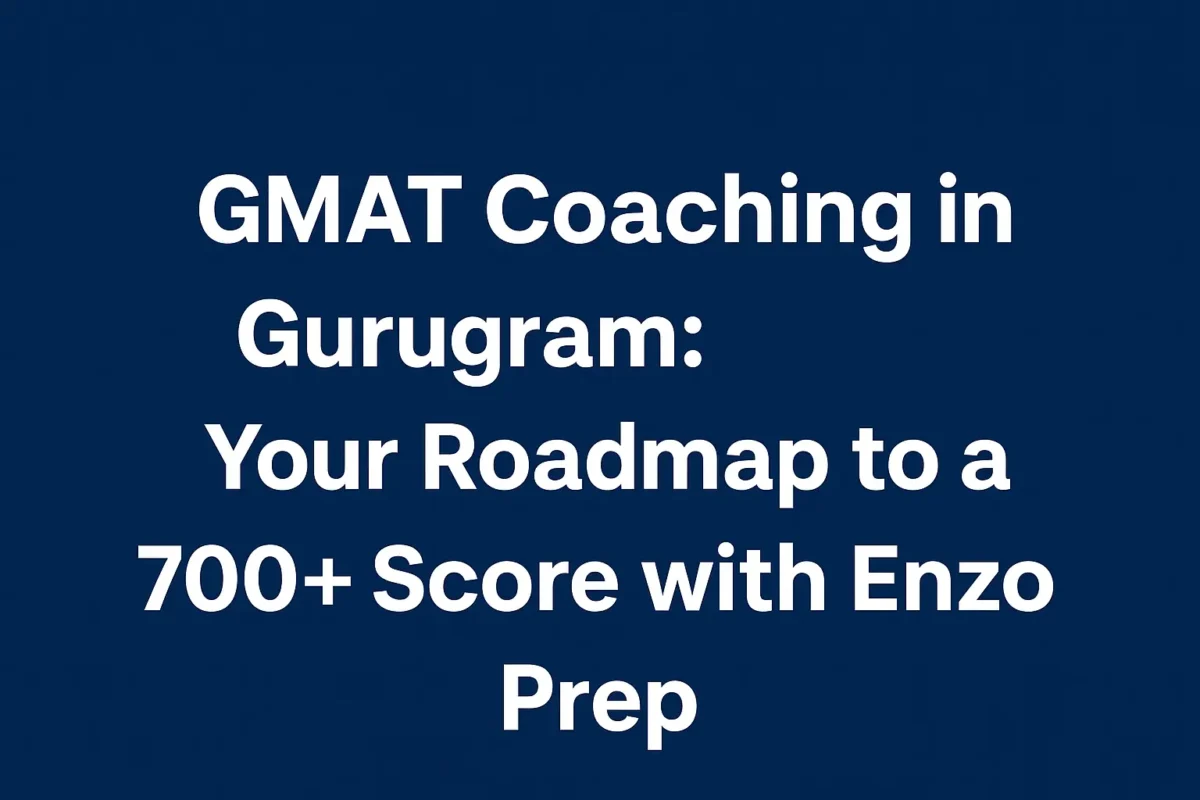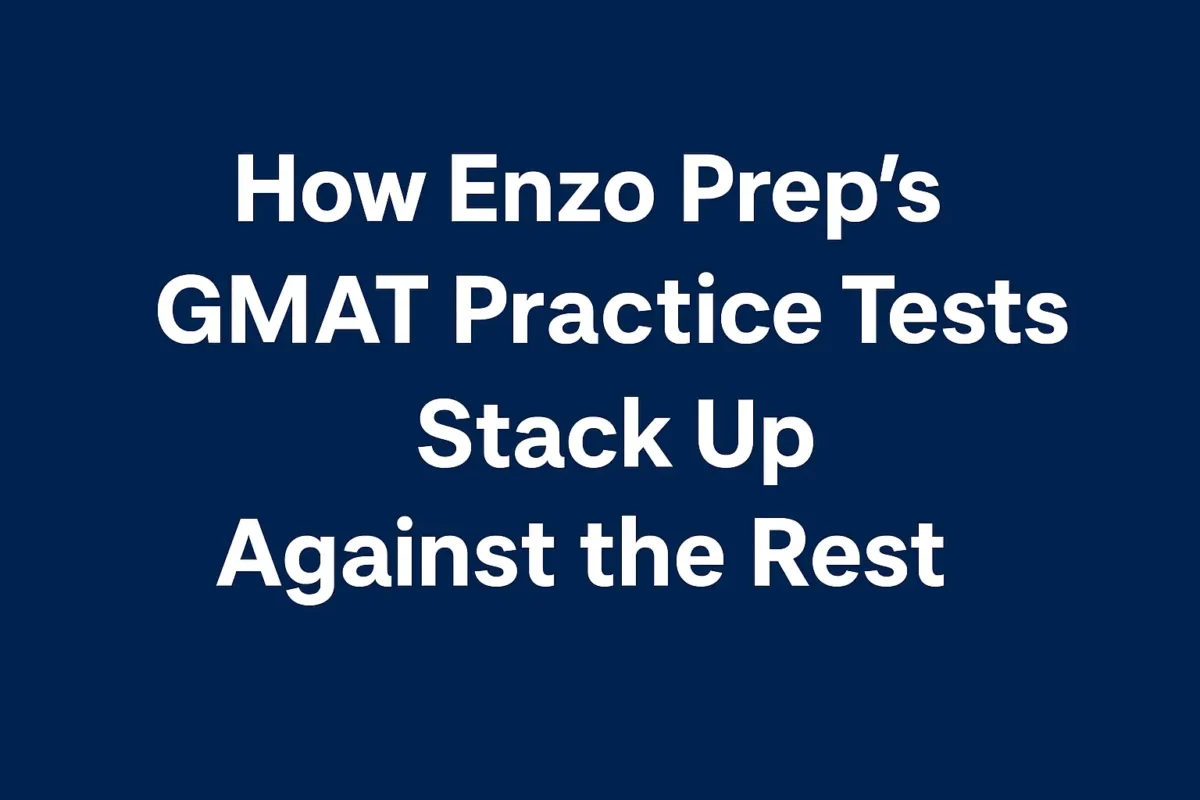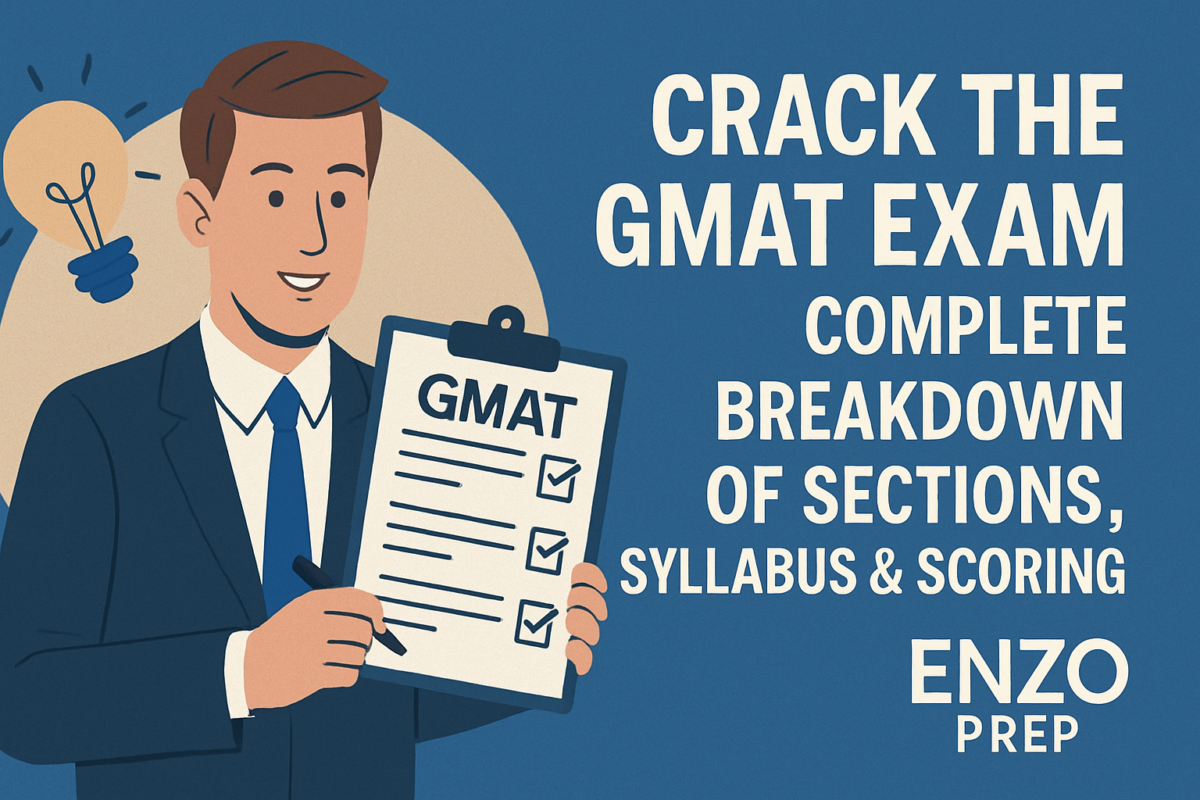Graduate business institutions all around the world use the Graduate Management Admission Test (GMAT), a standardized test, to evaluate applicants’ qualifications.
The GMAT assesses your reading, writing, analytical, quantitative, and verbal skills in standard written English.
The four primary sections of the assessment are the following: Verbal, Integrated Reasoning, Analytical Writing, and Quantitative. It is essential to comprehend the GMAT’s format and scoring system in order to prepare for it effectively and raise your score.
Overview of the GMAT Sections
- Quantitative Reasoning: Your capacity to examine information and make inferences using reasoning is evaluated in this part. You have 62 minutes to provide answers to the 31 questions on this test. Your mathematical abilities in arithmetic, algebra, and geometry will be tested by two different sorts of questions: problem solving and data sufficiency.
- Verbal Reasoning: This component assesses your ability to analyze arguments, read and comprehend written content, and edit written content to adhere to accepted standards of written English. It consists of 36 reading comprehension, sentence correction, and critical reasoning problems that must be completed in 65 minutes.
- Integrated Reasoning: This section assesses your capacity for data analysis and information evaluation across formats. It consists of twelve questions that must be answered in thirty minutes. The questions cover a variety of topics, including table analysis, graphics interpretation, multi-source reasoning, and two-part analysis.
- Analytical Writing Assessment (AWA): This section asks you to analyze an argument in order to assess your communication and critical thinking abilities. You have thirty minutes to create one essay. The essay assesses your capacity for critical thought and concept communication and is graded independently of the other components.
Scoring System and Benchmarks for Target Scores
- Quantitative and Verbal Sections: One point is awarded for each of the two sections, ranging from 6 to 51. The overall score, which ranges from 200 to 800 in 10-point increments, is then obtained by adding these scores together. Business schools mostly assess the total score; a score of 650 or above is regarded as competitive, while a score of 700 or higher is considered exceptional.
- Integrated Reasoning: This section is scored separately on a scale of 1 to 8, in one-point increments. A score of 6 or higher is generally considered good.
- Analytical Writing Assessment: The AWA is scored on a scale of 0 to 6, in half-point increments. A score of 4.5 or higher is considered effective and competitive.
Assessing Your Baseline
Knowing where you stand is crucial before you take on a hard GMAT preparation path. A diagnostic test is useful in this situation.
A diagnostic exam provides a starting point for assessing your present skills and aids in creating a customized study schedule that caters to your individual requirements. Let’s explore the significance of a diagnostic examination and the best ways to interpret the findings.
Importance of a Diagnostic Test
- Establishes a Starting Point: A diagnostic test provides a clear picture of your strengths and weaknesses across the GMAT sections. Knowing where you stand before you start preparing can help you set realistic improvement goals.
- Personalizes Your Study Plan: With a comprehensive understanding of your initial performance, you can tailor your study plan to focus more on areas that need improvement, thereby making your preparation more efficient.
- Helps in Goal Setting: By understanding your baseline scores, you can set specific, achievable score improvements for each section of the GMAT. This guides your preparation efforts and keeps you motivated.
- Familiarizes You with the Test Format: Taking a full-length diagnostic test also helps you become familiar with the GMAT’s format, timing, and question types, reducing anxiety and improving your test-taking strategy.
Analyzing Your Diagnostic Test Results
- Review Overall Performance: Start by looking at your total score and the individual scores for the Quantitative, Verbal, Integrated Reasoning, and Analytical Writing sections. Identify which sections are your strongest and which are your weakest.
- Dive Deeper into Section Scores: Within each section, analyze your performance on different question types (e.g., Problem Solving vs. Data Sufficiency in Quant, or Sentence Correction vs. Critical Reasoning in Verbal). This helps in pinpointing specific areas of weakness.
- Identify Patterns of Errors: Look for patterns in the questions you got wrong. Are you making careless mistakes, or are there specific content areas you don’t understand? Identifying these patterns will help you focus your study on the most critical areas.
- Assess Time Management: Note the sections or question types where you spent too much time. Efficient time management is crucial for the GMAT, and identifying timing issues early on allows you to adjust your test-taking strategy accordingly.
- Set Specific Improvement Targets: Based on your analysis, set specific targets for each section and question type. For instance, if you’re weaker in Quantitative Reasoning, you might set a goal to improve your Data Sufficiency questions performance by practicing specific strategies and reviewing foundational math concepts.
- Create a Focused Study Plan: Use your analysis to develop a study plan that allocates more time to your weaker areas while still maintaining your strengths. Include targeted practice, review of foundational concepts, and strategic test-taking practice.
An essential first step in your GMAT preparation process is taking a diagnostic test to determine your baseline.
It maximizes the effectiveness of your preparation time while also providing guidance for your study strategy.
Setting a Study Plan
Making a well-thought-out study strategy is essential to acing the GMAT.
A well-organized strategy considers your desired score, the amount of time you have to study, and the necessity of distributing your efforts throughout the GMAT’s several sections.
Here’s how to create a study plan that fits your objectives and availability and guarantees thorough preparation.
Tailoring a Study Schedule Based on Your Gmat Target Score and Available Time
- Define Your GMAT Target Score: Start by setting a clear GMAT target score. Research the average scores of admitted students to your target programs to set a realistic and specific goal.
- Assess Your Available Time: Consider how much time you have until your GMAT test date and how many hours per week you can realistically dedicate to studying. Remember, quality is more important than quantity; focused, uninterrupted study sessions are more effective.
- Evaluate Your Baseline Score: Based on your diagnostic test results, determine how much improvement you need to achieve your target score. This will help you gauge the intensity and duration of your study plan.
- Create a Study Calendar: Divide your available time into a weekly schedule, allocating specific hours to GMAT study. Ensure your plan is balanced with other commitments to avoid burnout.
- Allocate Time Based on Your Needs: Dedicate more time to areas where you need the most improvement, but don’t neglect your stronger areas. A balanced approach ensures steady progress in all sections.
- Incorporate Variety: Mix different study activities—such as practice questions, mock tests, and review sessions—to keep your preparation engaging and comprehensive.
- Plan for Regular Practice Tests: Schedule full-length practice tests every 2-4 weeks to monitor your progress and adjust your study plan as necessary. Practice tests also help improve your stamina and time management skills.
- Include Review and Rest Days: Regularly review what you’ve learned to reinforce memory and understanding. Equally important are rest days to prevent burnout and maintain long-term motivation.
Balancing Study Time Across GMAT Sections
- Quantitative Section: If this is a weaker area, start with foundational math concepts before moving on to more advanced topics and strategies for problem-solving and data sufficiency questions.
- Verbal Section: For non-native English speakers or those struggling with verbal questions, focus on building vocabulary, reading comprehension skills, and understanding grammar rules. Practice by reading complex texts and doing specific verbal exercises.
- Integrated Reasoning (IR): Since IR skills overlap with Quant and Verbal, use this section to apply your critical thinking and data analysis skills. Practice with a variety of graphs, tables, and multi-source reasoning questions.
- Analytical Writing Assessment (AWA): Though less emphasized, don’t neglect the AWA. Practice by analyzing arguments and writing essays, focusing on clarity, logic, and coherence.
- Flexibility is Key: Your study plan should be flexible. As you progress, your strengths and weaknesses may shift. Be prepared to adjust your schedule accordingly to focus on areas that require more attention.
- Seek Feedback: Use resources such as tutors, study groups, or online forums to get feedback on your performance, especially for AWA and IR sections.
Mastering GMAT Content
It takes more than simply effort to get a good score on the GMAT; you also need to understand the material in each segment of the test strategically.
Here’s how to approach each section in an efficient manner.
Quantitative Section Strategies
-
- Fundamental Math Skills and Shortcuts: Start by making sure you understand the fundamentals of geometry, algebra, and arithmetic. Acquire time-saving shortcuts and effective calculation techniques, like the rule of thumb for divisibility, rapidly squaring integers, and estimation.
- Practice Strategies for Problem-Solving and Data Sufficiency Questions:
-
- For Problem-Solving questions, practice identifying the fastest approach to solve a problem, whether it’s through direct calculation, estimation, or by choosing smart numbers.
- For Data Sufficiency questions, develop a systematic approach to evaluate each statement independently and then together. Focus on understanding what information is truly needed to answer the question rather than trying to solve it fully.
Verbal Section Strategies
- Reading Comprehension Techniques: By using active reading techniques, such as identifying the passage’s primary idea, tone, and purpose, you can increase your comprehension of what you read. To effectively collect information without being mired in detail, practice skimming tactics.
- Critical Reasoning Tactics: Pay attention to how arguments are structured by recognizing the premises, conclusions, and assumptions. Get practice by breaking down argument structures and figuring out the solution before considering the other options.
- Sentence Correction Tips: Pay attention to how arguments are structured by recognizing the premises, conclusions, and assumptions. Get practice by breaking down argument structures and figuring out the solution before considering the other options.
Integrated Reasoning and Analytical Writing
- Approaches to Multi-Source Reasoning, Graphics Interpretation, and Table Analysis:
-
- For Multi-Source Reasoning, practice synthesizing information from different formats and sources quickly.
- In Graphics Interpretation, focus on understanding and interpreting data from graphs and charts efficiently.
- For Table Analysis, develop skills to analyze and sort data in tables to answer what the question requires.
- Structuring Your Analysis of an Argument Essay: The AWA section tests your ability to think critically and communicate your ideas effectively. Practice by:
- Clearly identifying the argument’s conclusion, evidence, and underlying assumptions.
- Organizing your essay into an introduction, a few body paragraphs each analyzing a specific part of the argument, and a conclusion.
- Providing specific examples to support your critique of the argument.
General Tips for All Sections
- Practice Under Timed Conditions: Simulate test-day conditions by practicing under time constraints. This will help improve your time management skills and reduce anxiety on the actual test day.
- Review and Analyze Your Mistakes: After each practice session or mock test, spend time reviewing your answers, especially the incorrect ones. Analyze why you got a question wrong and how you can avoid similar mistakes in the future.
- Utilize Official GMAT Materials: While third-party resources can be helpful, ensure that you also practice with official GMAT materials to get accustomed to the language and style of questions you’ll encounter on the test.
- Stay Consistent and Positive: Consistency is key to mastering GMAT content. Set a regular study schedule, and maintain a positive mindset throughout your preparation journey.
You’ll be well on your way to understanding the GMAT’s material and hitting your goal score if you utilize these tactics and commit to consistent, concentrated preparation.
Test-Taking Strategies
A solid understanding of the subject matter is necessary for doing well on the GMAT, but so are efficient test-taking techniques, particularly with regard to guesswork, time management, and stress reduction. Here’s how to work your way around these elements to maximize test performance.
Time Management During the Test
- Know the Format: Familiarize yourself with the timing and structure of the GMAT. Allocate an average time per question for each section and stick to it. For instance, you have about 2 minutes per question in the Quantitative section and about 1.75 minutes per question in the Verbal section.
- Use a Timing Strategy: Break down each section into smaller blocks (e.g., plan to complete 10 questions every 20 minutes in Quant). Regularly check the clock to ensure you’re on pace and adjust your speed as needed.
- Prioritize Wisely: Spend more time on questions that play to your strengths and less on questions that you find extremely challenging. This ensures you’re maximizing your score potential.
Guessing Strategies and When to Skip Questions
- Smart Guessing: If you’re stuck, eliminate as many wrong answers as possible to improve your chances if you have to guess. Look for patterns in answer choices or common traps.
- When to Skip: The GMAT doesn’t allow you to skip and return to questions later. However, if you find a question too challenging and time-consuming, make your best guess and move on. Spending too much time on a single question can jeopardize your ability to answer others.
- Avoid Random Guessing Early On: Since the GMAT is computer-adaptive and questions early in the test can significantly impact your score, try to make educated guesses rather than random ones, especially in the initial questions.
Managing Test Day Stress and Anxiety
- Be Well Prepared: The best way to reduce test day anxiety is through thorough preparation. Familiarity with the test format and types of questions you’ll encounter can significantly ease your nerves.
- Practice Relaxation Techniques: Learn and practice relaxation techniques such as deep breathing, visualization, or progressive muscle relaxation in the weeks leading up to the test. Use these techniques before the test and during breaks to stay calm.
- Simulate Test Conditions: Take full-length practice tests under conditions that mimic the test day, including timing, breaks, and even the meal you plan to eat beforehand. This can help reduce anxiety related to unfamiliarity.
- Have a Test Day Plan: Know the logistics of your test day in advance—how to get to the test center, what you need to bring, and what the check-in procedure looks like. Arrive early to avoid any last-minute stress.
- Focus on What You Can Control: Concentrate on your preparation and strategies rather than worrying about the outcome. Remember, you can retake the GMAT if necessary, so give it your best shot but know it’s not your only opportunity.
- Use Short Breaks Wisely: During the test, you’ll have two optional breaks. Use these to stretch, hydrate, snack, and reset your mind for the next section.
Success on the GMAT depends on a combination of careful planning, methodical research, and efficient test-taking strategies.
The most important things are to master the material in every section, manage your time well, and remain composed under duress. Achieving your desired score can be a real goal with commitment, a customized study schedule, and an optimistic outlook.
For those aspiring to improve your GMAT score, Enzo Prep offers comprehensive preparation strategies for the GMAT, ensuring that your candidacy stands out in the competitive landscape of MBA admissions.
Connect us Enzo Prep Today!














